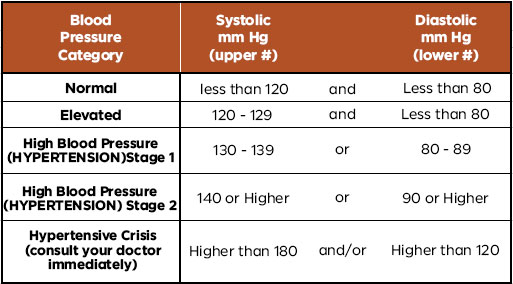August 12, 2024
The American Heart Association (AHA) and the American College of Cardiology (ACC) issued new guidelines for evaluating blood pressure in adults in 2017, lowering what was once considered to be the normal blood pressure range. This change sparked a lot of attention in the news since it was the first time in 14 years that high blood pressure was redefined – the last update prior was 2003. Overall the change in these guidelines are designed to help people address the potentially deadly condition much earlier and change the way they think about their blood pressure and health. So how much do you know? Let’s start with blood pressure 101 and walk you through the basics to help you better understand what blood pressure is and why it is so important to our health.
What is Blood Pressure and Why is it Important?
Blood pressure is the force created by the amount of blood your heart pumps and the resistance to blood flow in your arteries. It’s an important because oxygen and nutrients could not be pushed around the circulatory system to nourish tissues and organs without blood pressure. Your blood pressure rises and falls naturally throughout the day, but the higher your blood pressure, the harder your heart must work. High blood pressure, or hypertension, is often called a silent killer, because you may not feel that anything is wrong. If the pressure in your arteries is high enough, and uncontrolled, it may eventually cause serious health problems, including heart attack and stroke.1 It’s a risk indicator for much more serious health conditions, which is why it makes it important to have your blood pressure checked regularly. On the other end, low blood pressure, or hypotension, is not typically as worrisome as high blood pressure. However, it can still indicate health issues.
How is Blood Pressure Measured?
If your blood pressure is measured just once and found to be high, it doesn't necessarily mean that it's always like that. A reading taken at the doctor’s office can sometimes be misleading. Going to the doctor makes some people so nervous that their blood pressure goes up. This is called “white coat syndrome.” As many as 1 in 3 people who have a high blood pressure reading at the doctor’s office may have normal blood pressure readings outside of it.2
Additional factors that could increase your measurement could be caused by physical exertion, stress, pain or extreme heat or cold – but it is only temporary, and eventually returns to normal.
It’s important to know the correct way to have your blood pressure taken, whether you’re getting it checked by a health care professional or checking it yourself at home. Here are some tips from the CDC:2
- Don’t eat or drink anything 30 minutes before you take your blood pressure.
- Sit in a comfortable chair with your back supported for at least 5 minutes before your reading.
- Put both feet flat on the ground and keep your legs uncrossed.
- Rest your arm with the cuff on a table at chest height.
- Make sure cuff is snug but not too tight and its against your bare skin, not over clothing.
- Do not talk while your blood pressure is being measured.
This means sitting down and relaxing on a chair and waiting about three minutes before taking a measurement so that your circulatory system comes to rest. The upper arm that is being used for the measurement should rest on a table, at about the same height as the heart, while the reading is being done.
Blood pressure is typically measured with a sphygmomanometer, commonly known as a blood pressure cuff. If you’ve ever been to a doctor’s office or an urgent care center, you’re probably familiar with the cuff they place around your upper arm. As the health care professional inflates the cuff, it will gently tighten on your arm. The cuff tightens until your circulation is cut off, then a gauge or stethoscope is used to listen to the pulse of the blood as the cuff releases.
Understanding Blood Pressure Readings
When you measure your blood pressure, you’re testing two types of pressure. The pressure exerted against your arteries when the heart pumps and when the heart is at rest. This pressure is the result of two forces, which make up the two numbers in a blood pressure reading:4
Systolic (top number): The force from when blood pumps from your heart to your arteries.
Diastolic (bottom number): The pressure between heart beats.
The definition of high blood pressure was lowered with the changes to the BP guidelines in 2017. With this, there have also been some changes to the terminology, so you may hear some new language from your healthcare professionals. Namely, the term “prehypertension” has been replaced with the term “elevated.”4 So moving forward, the five blood pressure ranges recognized by the American Heart Association are:5

Normal (<120/<80) : If your results fall into this category, stick with heart-healthy habits like following a balanced diet and getting regular exercise.
Elevated (120-129/<80): Elevated blood pressure is a warning sign. It means you need to pay attention to your blood pressure and focus on heart-healthy habits.
Hypertension Stage 1 (130-139/80-89): At this stage of high blood pressure, doctors are likely to prescribe lifestyle changes and may consider adding blood pressure medication based on your risk of atherosclerotic cardiovascular disease (ASCVD), such as heart attack or stroke.
Hypertension Stage 2 (>140/>90): At this stage of high blood pressure, doctors are likely to prescribe a combination of blood pressure medications and lifestyle changes.
Hypertensive Crisis (>180/>120) : This stage of high blood pressure requires medical attention. Do not wait to see if your pressure comes down on its own if you are experiencing chest pain, shortness of breath, back pain, numbness/weakness, change in vision or difficulty speaking. Immediately call 911.
How is Blood Pressure Managed?

Always consult your primary care provider before changing any diet or exercise routines. If you have high blood pressure or you want to lower it, the first step you can do is implement a healthy lifestyle. This includes being more physically active, eating a healthy diet and managing your stress. But for some, If you have moderate to extreme high blood pressure, medication may be necessary to help control it.
Here’s a few additional practical tips from the ACC’s CardioSmart Program:6
- Maintain a healthy body weight.
- Follow the DASH (Dietary Approaches to Stop Hypertension) Diet. This diet incorporates a lot of fruits, veggies, and low-fat dairy.
- Reduce your salt intake.
- Eat lots of potassium-rich foods like bananas and spinach. Potassium is an important mineral that helps our bodies counteract the negative effects of salt.
- Get out there and get moving. Strive for 30 minutes of physical activity per day.
- Cut back on the drinks. Limit alcohol to no more than one drink per day if you’re a woman and two drinks per day if you’re a man.
- Manage your stress levels through meditation, time management, and relaxation techniques.
MedExpress Pro Tip: If you have high blood pressure, aim to consume less than 1,500 mg of sodium per day.
The Bottom Line
It’s always important to know your blood pressure numbers and understand your individual risk factors. Share this information with your family and children. Have regular conversations about health risk factors that might run in your family, so as children get older, they have a solid understanding of their medical history and whether or not high blood pressure runs in the family.
Keeping your blood pressure within a normal range is key to preventing complications, such as heart disease and stroke. Remember that a single blood pressure reading doesn’t necessarily classify your health and that an average of readings taken over time is the most accurate. That’s why it’s important to have your blood pressure taken by a healthcare professional at least once a year and talk with your doctor if you think you are at risk for developing high blood pressure, and ask questions about management if you have been diagnosed with high blood pressure.
Originally published February 2018. Updated August 2024.
This content was medically reviewed by a MedExpress physician.
References:
1 American Heart Association. What is High Blood Pressure? Accessed December 1, 2022.
2 CDC. Measure Your Blood Pressure. Last updated May 15, 2024. Accessed August 12, 2024.
3 National Library of Medicine. What is blood pressure and how is it measured? Last updated May 23, 2019. Accessed December 1, 2022.
4 American College of Cardiology. High Blood Pressure Guidelines Lower Definition of Hypertension. Published Nov. 13, 2017. Accessed Jan. 6, 2018.
5 American Heart Association. Understanding Blood Pressure Readings. Last updated Nov 30, 2017. Accessed December 1, 2022.
6 American College of Cardiology CardioSmart. High Blood Pressure. Last reviewed Nov. 2017. Accessed Jan. 6, 2018

